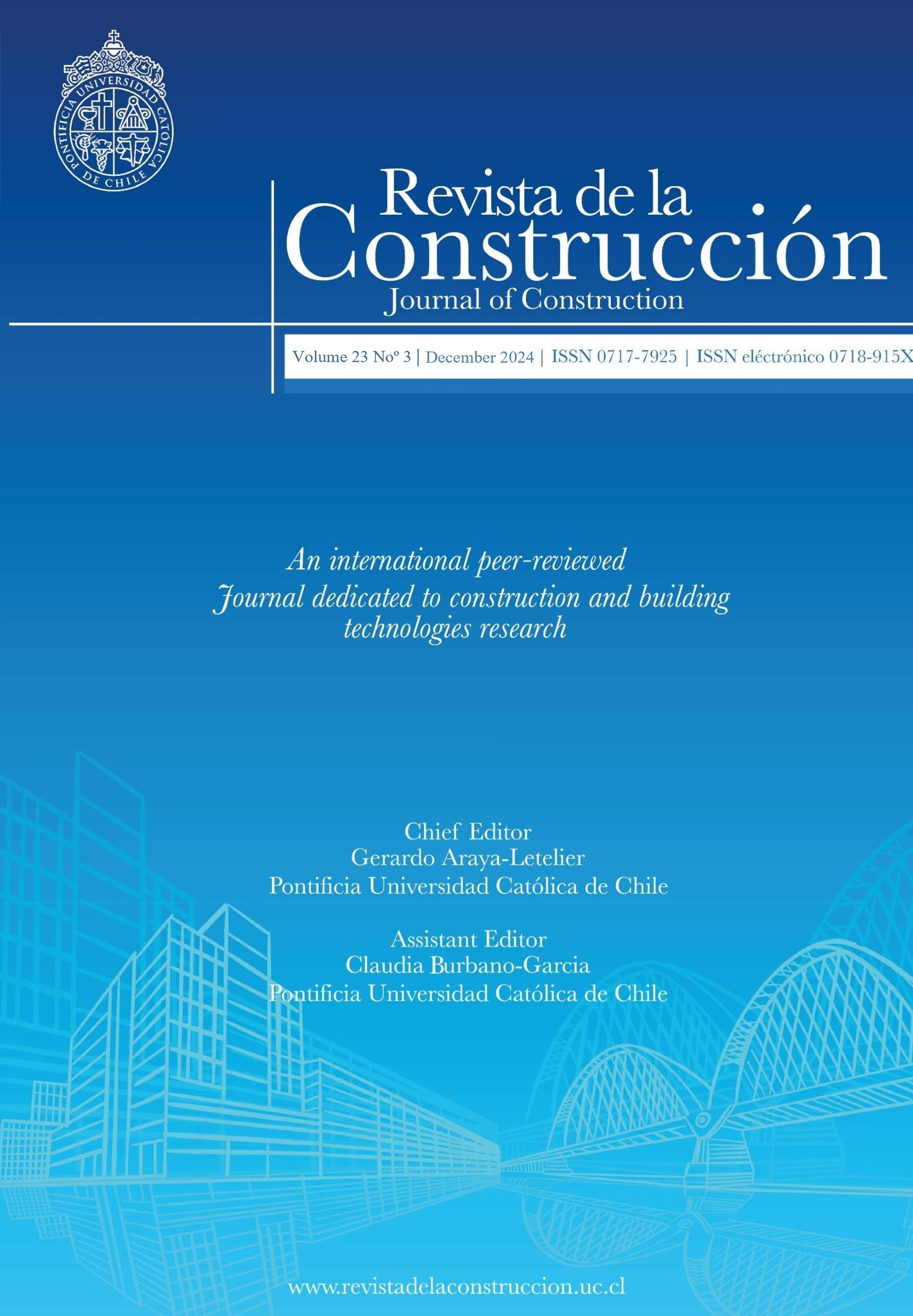Prediction of capillary absorption and compressive strength, applying multiple linear regression and artificial neural networks in concrete with natural pozzolana addition
DOI:
https://doi.org/10.7764/RDLC.23.3.568Keywords:
Pozzolans, capillary absorption, compression, linear multiple regression, artificial neural network.Abstract
Cement is the fundamental binder of concrete, and its manufacture has a significant impact on the environment; therefore, it is necessary to look for eco-sustainable alternatives, including additions such as natural pozzolana, which affect the internal matrix of concrete and therefore the compressive strength and capillary absorption of concrete. In this context, prediction models for capillary absorption and compressive strength of concrete with pozzolana additions have been determined by applying linear multiple regression tools and artificial neural networks which will help reduce laboratory testing costs and times. For this purpose, 16 types of mixtures were designed with w/c ratios of 0.40, 0.45, 0.50 and 0. 55 and addition of 10, 15 and 20% of pozzolana; 160 cylindrical samples were manufactured and tested in laboratory, the values of capillary absorption and compressive strength at 28 and 56 days of curing were determined; the effect of each variable on the results obtained indicated that 15% pozzolana significantly improved the properties studied; using the data of the manufacturing variables of each design and the results of capillary absorption and compressive strength, prediction models were obtained for both properties; the best back propagation neural networks (BPNN) structure is [10,20,10,1], with R2compression=0. 9486 and R2capillary absorption=0.9756; while the models obtained with multiple linear regression obtained R2compression = 0.9391 and R2capillary absorption = 0.8693; both techniques showed a high reliability for the prediction of compressive strength and capillary absorption.
Downloads
References
Al-Swaidani, A., Khwies, W., Al-Baly, M. and Lala, T. (2022). Development of multiple linear regression, artificial neural networks, and fuzzy logic models to predict the efficiency factor and durability indicator of nano natural pozzolana as cement additive. Journal of Building Engineering, Volume 52,2022,104475, ISSN 2352-7102, https://doi.org/10.1016/j.jobe.2022.104475.
Dantas,A. , Mônica Batista Leite, Koji de Jesus Nagahama. (2013). Prediction of compressive strength of concrete containing construction and demolition waste using artificial neural networks. Construction and Building Materials,Volume 38, 2013,Pages 717-722,ISSN 0950-0618, https://doi.org/10.1016/j.conbuildmat.2012.09.026.
Deboucha, W., Oudjit, M., Bouzid, A. and Belagraa, L. (2015). Effect of Incorporating Blast Furnace Slag and Natural Pozzolana on Compressive Strength and Capillary Water Absorption of Concrete. https://doi.org/10.1016/j.proeng.2015.06.145
Deshpande, N., Londhe, S. and Kulkarni, S. Modeling compressive strength of recycled aggregate concrete by Artificial Neural Network, Model Tree and Non-linear Regression. International Journal of Sustainable Built Environment, Volume 3, Issue 2, 2014, Pages 187-198, ISSN 2212-6090, https://doi.org/10.1016/j.ijsbe.2014.12.002.
Khademi, F., Sayed Mohammadmehdi Jamal, Neela Deshpande and Shreenivas Londhe. Predicting strength of recycled aggregate concrete using Artifi-cial Neural Network, Adaptive Neuro-Fuzzy Inference System and Multiple Linear Regression, International Journal of Sustainable Built Environ-ment, Volume 5, Issue 2, 2016, Pages 355-369, ISSN 2212-6090, https://doi.org/10.1016/j.ijsbe.2016.09.003.
Hanumanthu, K. and Sarkar, K. Improved sorptivity models for mortar and concrete based on significant process parameters. Journal of Building Engi-neering, Volume 47, 2022, 103912, ISSN 2352-7102, https://doi.org/10.1016/j.jobe.2021.103912.
Hammat, S., Menadi, B., Kenai, S., Thomas, C., Kirgiz, M. and SOUSA GALDINO, A. (2021). The effect of content and fineness of natural pozzolana on the rheological, mechanical, and durability properties of self-compacting mortar. Journal of Building Engineering, Volume 44, 2021, 103276, ISSN 2352-7102, https://doi.org/10.1016/j.jobe.2021.103276.
Jayswal, S. and Mungule, M. (2022). Microstructure evolution and strength development for pozzolana blended cement mortar. Materials Today: Pro-ceedings, 2022, ISSN 2214-7853, https://doi.org/10.1016/j.matpr.2022.11.237
Levenberg, K., "A Method for the Solution of Certain Problems in Least Squares," Quart. Appl. Math. Vol. 2, pp 164-168, 1944.
Liu, B., Shi, J., Zhou, F., Shen, S., Ding, Y. and Qin, L. (2020). Effects of steam curing regimes on the capillary water absorption of concrete: Prediction using multivariable regression models. Construction and Building Materials, Volume 256, 2020, 119426, ISSN 0950-0618, https://doi.org/10.1016/j.conbuildmat.2020.119426.
López, M. and Castro, J. (2010). Efecto de las puzolanas naturales en la porosidad y conectividad de poros del hormigón con el tiempo. Revista ingeniería de construcción, 25(3), 419-431. https://dx.doi.org/10.4067/S0718-50732010000300006
Lothenbach, B., Scrivener, K. and Hooton, R. (2011). Supplementary cementitious materials. Cement and Concrete Research, Volume 41, Issue 12, 2011, Pages 1244-1256, ISSN 0008-8846, https://doi.org/10.1016/j.cemconres.2010.12.001.
Marquardt, D., "An Algorithm for Least-Squares Estimation of Nonlinear Parameters," SIAM J. Appl. Math. Vol. 11, pp 431-441, 1963.
McCarthy, M.J. and Dyer, T.D. (2019). Pozzolanas and Pozzolanic Materials, Editor(s): Peter C. Hewlett, Martin Liska, Lea's Chemistry of Cement and Concrete (Fifth Edition), Butterworth-HeinemRNA, Pages 363-467, ISBN 9780081007730, https://doi.org/10.1016/B978-0-08-100773-0.00009-5
Medeiros-Junior, R. A., Munhoz, G. S., Medeiros, M. H. F. (2019). Correlaciones entre absorción de Water, Resistividad eléctrica y resistencia a la compre-sión de concreto con diferentes contenidos de puzolana. Revista ALCONPAT, 9 (2), pp. 152 – 166, DOI: http://dx.doi.org/10.21041/ra.v9i2.335
Nagarajan, D., Rajagopal, T., and Meyappan, N. (2020). A comparative study on prediction models for strength properties of LWA concrete using artifi-cial neural network. Revista De La Construcción. Journal of Construction, 19(1), 103–111. https://doi.org/10.7764/RDLC.19.1.103-111
O. DENEME, I. (2020). Modelling of compressive strength of self-compacting concrete containing fly ash by gene expression programming. Revista De La Construcción. Journal of Construction, 19(2), 346–358. https://doi.org/10.7764/rdlc.19.2.346-358
Tam, V., Butera, A., Le, K., Da Silva, L. and Ana C.J. Evangelista (2022). A prediction model for compressive strength of CO2 concrete using regression analysis and artificial neural networks. Construction and Building Materials, Volume 324, 2022,126689, ISSN 0950-0618, https://doi.org/10.1016/j.conbuildmat.2022.126689.
Tasdemir, C. (2003). Combined effects of mineral admixtures and curing conditions on the sorptivity coefficient of concrete. Cement and Concrete Research, Volume 33, Issue 10, 2003, Pages 1637-1642, ISSN 0008-8846, https://doi.org/10.1016/S0008-8846(03)00112-1
Waghmare, S., Katdare, A. and Patil, N. (2022). Studies on computing compressive strength of zeolite blended concrete using multiple regression analysis. Materials Today: Proceedings, Volume 49, Part 5, 2022, Pages 1239-1245, ISSN 2214-7853, https://doi.org/10.1016/j.matpr.2021.06.296.
Yanguatin, H, Tobón, J, and Ramírez, J. (2017). Reactividad puzolánica de arcillas caoliníticas una revisión. Revista ingeniería de construcción, 32(2), 13-24. https://dx.doi.org/10.4067/S0718-50732017000200002
Zhuang, S., Wang, Q. and Zhang, M. (2022). Water absorption behavior of concrete: Novel experimental findings and model characterization. Journal of Building Engineering, Volume 53, 104602, ISSN 2352-7102, https://doi.org/10.1016/j.jobe.2022.104602.
ASTM C 39/C 39M: The American Society for Testing Materials, Standard Test Method for Compressive Strength of Cylindrical Concrete Specimens, West Conshohocken (PA), VSA (2001).
ASTM C1585-13, Standard Test Method for Measurement of Rate of Absorption of Water by Hydraulic-Cement Concretes. Obtained from: www.astm.org, 2013
ASTM C618-23 Standard Specification for Coal Ash and Raw or Calcined Natural Pozzolana for Use in Concrete
ASTM C150/C150M-22 Standard Specification for Portland Cement
The MathWorks Inc. (2018). MATLAB version R2018b, Natick, Massachusetts: The MathWorks Inc. https://www.mathworks.com
Downloads
Published
How to Cite
Issue
Section
License
Copyright (c) 2024 Ana Victoria Torre Carrillo, Pedro Espinoza Haro, Sorin Gudberto Ramirez Curi, Isabel Moromi Nakata, Luisa Esther Shuan Lucas, Matías Ramos Jesús Aldair

This work is licensed under a Creative Commons Attribution-NonCommercial-NoDerivatives 4.0 International License.








